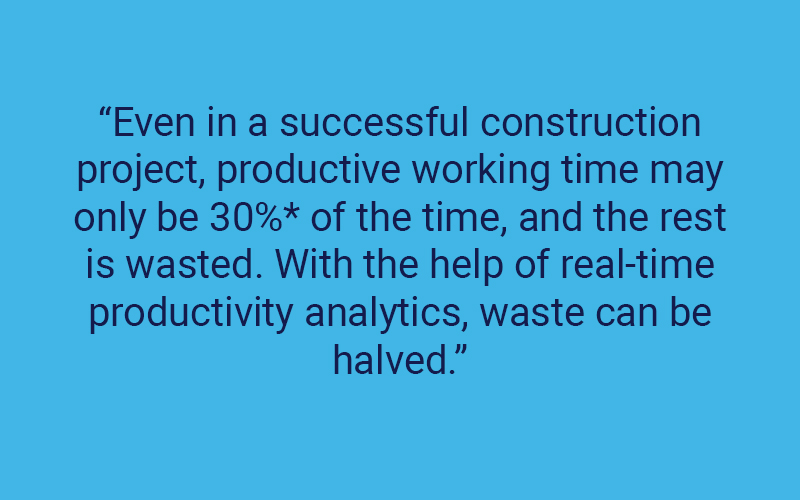Real-time productivity analytics is the next big thing in the construction industry. With the help of real-time productivity analytics, you can ensure the prerequisites, increase the proportion of uninterrupted working time and improve the workflow at the jobsite.
Result? A smoothly running construction site and shortened programme time.
The amount of uninterrupted work is critical
Productivity has been a hot topic in the construction industry for a long time, and today companies put a lot of effort into productivity improvement.
Productivity is about how well the available resources are utilized. Doing more with less and with defined quality. This means that the daily production speed is sufficient and correlates with the schedule and costs.
For the work to be productive and efficient, there should be no additional unforeseen situations. However, they constantly come up on construction sites.
From the workflow point of view, the most critical thing is the proportion of uninterrupted work time used for carrying out the tasks on the site. Real-time productivity analytics is a new way to solve productivity problem in the construction industry.
What is real-time productivity analytics?
Real-time productivity analytics transforms abstract terms into measurable values. Real-time productivity analytics measures uninterrupted working time and reflects it on the planned schedule.
For example, the installation team is allocated x h time to complete one task, and it takes exactly that time to complete the task. Good enough? Productivity analytics tells us how much of that time was spent doing the actual work.
What is the point here for site management? Aiforsite’s system will show you how many workers have been planned for certain tasks, how many workers were actually doing the work in a given time and is the task completed according to the schedule.
By using the solution, project management:
- learns how much time the performance of work tasks requires in reality
- plans contract works more efficiently
- is always on top of the situation
Why should you be interested in the installer’s productivity?
Construction relies heavily on subcontracting, and the general contractors may easily think that as long as a subcontractor manages the contract, it doesn’t matter how he does the work. His responsibility, his risk.
If, for example, a mechanical contractor says he will do the job for a lump sum in ten weeks and keeps his promise, the general contractor is not interested in how productive the installers of the mechanical company are. The main contractor may think doing a job in ten weeks is highly productive. However, the truth may be that 60% of these ten weeks are actually doing nothing.
What if we think about the above example from a different perspective? Construction is a team game, and everyone’s contribution affects the final result. Too big schedule buffers are a waste, and they can be revealed with the help of productivity analytics. Together, we can influence the efficiency and productivity of the entire project.

Time spent on unproductive work, such as waiting and looking for materials or tools, is also a waste.
Productivity analytics makes waste visible, helps to identify the root causes of disruptions and to eliminate deviations. It provides analysis by the working area, task and resource level.
If you use real-time productivity analytics consistently in all your construction projects, you will achieve tremendous long-term benefits: shorten project completion times, improve construction quality, and ensure excellent documentation.
The real-time productivity analytics utilises positioning data
The real-time productivity analytics developed by Aiforsite is based on positioning data and visual situational awareness. The tools and installers are equipped with sensors (personal data is not stored, and the purpose is not to track individuals) to monitor uninterrupted working hours and detect deviations in the process.
So, the data collection is automated and does not require manual input of information or extra hours from the site management.
When you start to use the solution, you form a better understanding of how much time is actually spent on different work tasks and which aspects cause waste.
After you’ve tracked productivity in more projects over a longer period, you start to learn how to make continuous improvements in a new way. You can compare the performance results with data from previous projects, and you make sure that the improvements you achieved in the past are carried over to new projects.
Productivity engineer – the detective on site
What does the implementation of real-time productivity analytics require?
- Implementing the solution requires, above all, a desire to solve the productivity problem. Real-time productivity analytics is the next big thing in the construction industry, and by using Aiforsite, you will be a pioneer in solving the industry’s biggest problem.
- On an operational level, real-time productivity analytics requires the deployment of new digital tools and the automation of data collection to obtain a real-time situational picture.
- The third prerequisite is open communication with stakeholders and joint efforts for waste elimination. This does not require a major change to your current processes, as site and subcontractor meetings are already part of your everyday life. Real-time productivity analytics provides the prerequisites to lead discussions based on the data and present concrete initiatives for improvement.

*Research Study 2022: Uncovering & Visualizing Work Process Interruptions Through Quantitative Workflow Analysis
